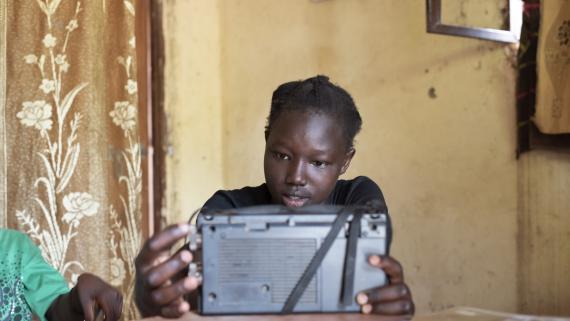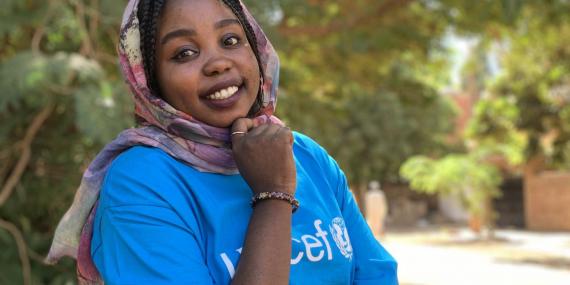Port Sudan, Sudan
Enas is from Port Sudan in eastern Sudan’s Red Sea State. As a young person who is deaf, Enas is passionate about raising awareness, and advocating for the rights of persons with disabilities and special needs, the right to education and women’s empowerment. “I will support, raise awareness and encourage people with disabilities to speak up and participate, know their rights, demand [their rights] and help each other realize their rights," she said. "It is Important to hear voices of youth, especially [those] with disabilities because they are the future.” UNICEF Sudan
Young people continue to feel the impacts of the COVID-19 pandemic, especially those living in disadvantaged circumstances. Despite this group’s lower immediate health risk from COVID-19, their protection needs can be severely affected when caregivers are infected, quarantined or pass away, compromising their access to shelter, food and education if they are forced to procure a livelihood.
Economic and employment prospects for young people – already tough before the pandemic – have become even more dire. The proportion of youth who are not engaged in employment, education or training activities (the youth NEET rate) has remained stubbornly high over the past 15 years. It now stands at 30 per cent for young women and 13 per cent for young men worldwide. An estimated 600 million jobs would have to be created over the next 15 years to meet youth employment needs.
Proportion of youth not in education, employment or training (NEET)
During lockdown, and in this context of overall economic and social distress, children and adolescents are at increased risk of domestic violence. Young women and girls are at higher risk of experiencing GBV if confined with their abusers, or sexual exploitation and child, early and forced marriage if the family experiences hardships while access to support services is severely disrupted. Unaccompanied and separated children, including those living on the streets, are also at increased risk of sexual exploitation and abuse. These impacts are further amplified in humanitarian contexts where conflict, fragility and other emergencies have undermined institutional capacity and limited access to services.
Education in emergencies: The lingering effects of COVID-19

When COVID-19 hit, Governments responded by temporarily closing schools, impacting 91 per cent (1.6 billion) of students worldwide. At least 463 million children – a third of those affected by closures – were unable to access any remote learning during school closures. By September 2020, UNICEF reported that out of 158 countries surveyed about their school reopening plans, one in four had not put a date in place for allowing schoolchildren back into the classroom. The loss of educational opportunities has undermined productivity, reduced lifetime earnings and widened inequalities. The economic fallout of the pandemic could cause a loss of $10 trillion in earnings over the lifetime of this current generation of children, pushing up to 86 million more children and young people into household poverty by the end of 2020.3 Worryingly, the loss of educational opportunities also raises other protection concerns that will reverberate through next year, especially in fragile settings. UNESCO estimates that 23.8 million children, adolescents and young people are at risk of not returning to school in 2020, including 11.2 million girls and young women. Failure to return to school increases the risk of a rise in physical and emotional violence, sexual exploitation and abuse, and the recruitment of children by armed groups. Millions of children could be forced into child labour, which would mark the first increase in child labour since 2000. In particular, the longer adolescent girls are out of school, the less likely they are to return as education disruptions greatly increase their risks of child, early and forced marriage and adolescent pregnancy. Failure to return to school also closes the door on an early intervention opportunity to identify domestic violence and provide nutritional support and routine immunizations or basic health screenings. Nearly 369 million children lost access to school meals in 2020 due to school closures, many of whom relied on these meals for their nutrition. The loss of these pre-emptive opportunities could result in broader humanitarian needs in 2021 and beyond.
UNICEF/Helene RyengDespite these impacts, young people have mobilized at an unprecedented scale to respond to the pandemic and other global crises. Young medical professionals and students are providing essential health care or engaging in advocacy and information campaigns. Many are volunteering to support older persons and other vulnerable populations, and are contributing as scientists, social entrepreneurs, and innovators.
As the pandemic forces the world indoors, young people have embraced digital media to make their voices heard, and they are engaging in collective action on issues such as social injustice, racial discrimination and climate change. The youth-led climate change movement, Fridays for Future, has moved online, launching a hashtag for climate action. Youth-led civil- society organizations, such as #DefyHateNow in South Sudan, have launched community initiatives to fight misinformation, share best practices, and raise awareness on COVID-19 prevention and protection. This new level of engagement presents a unique opportunity for the international humanitarian system to integrate youth perspectives and leadership, ensuring humanitarian action is more inclusive for young people.
Further reading
Source: UNICEF
Source: ILO
Source: UNICEF
Source: World Vision International
References
- UN Department of Economic and Social Affairs (DESA), World Youth Report 2020 – Youth Social Entrepeneurship and the 2030 Agenda, July 2020
- United Nations, Policy Brief: The Impact of COVID-19 on Women, April 2020.
- Compact for Young People in Humanitarian Action, COVID-19: Working with and for Young People, May 2020
- Save the Children, Fact Sheet - Child Protection in Emergencies, 2010.
- Fore, UNICEF Executive Director remarks on new updated guidance on school-related public health measures in the context of COVID-19, 15 September 2020; UNICEF, Are children able to continue learning during COVID-19 closures?, August 2020 and UNICEF, Keeping the World’s Children Learning Through COVID-19, 20 April 2020.
- UNESCO, Act now: reduce the impact of COVID-19 on the cost of achieving SDG 4, September 2020.
- UNICEF and ILO, COVID-19 and child labour: a time of crisis, a time to act, June 2020.
- Compact for Young People in Humanitarian Action, COVID-19: Working with and for Young People, May 2020
- UNICEF, Pandemic Participation: Youth Activism Online in the COVID-19 Crisis, 14 April 2020
- UNICEF, Pandemic Participation: Youth Activism Online in the COVID-19 Crisis, 14 April 2020
- Wickramanayake, Jayathma, Meet 10 Young People Leading the COVID-19 Response in their Communities, 3 April 2020





